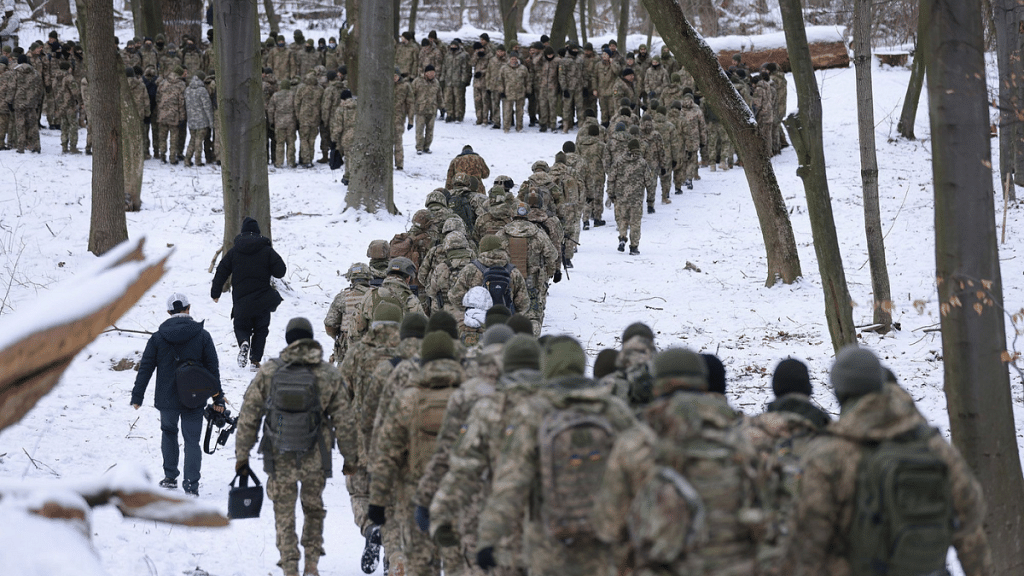Washington: The U.S. is putting as many as 8,500 troops on heightened alert for deployment to bolster NATO forces in Eastern Europe if needed as Russian troops mass on Ukraine’s borders, offering a show of military force alongside diplomatic efforts to defuse the crisis.
“It’s very clear that the Russians have no intention right now of de-escalating,” so it makes “prudent sense” to give U.S. military personnel time to prepare if NATO activates its Response Force along the alliance’s eastern flank, Defense Department spokesman John Kirby told reporters Monday at the Pentagon.
Kirby repeatedly said the troops aren’t being deployed yet and wouldn’t be sent into Ukraine. He said “there is time and space” for diplomacy but that Russia continues to increase the forces arrayed along its border with Ukraine — which top 100,000 — and in Belarus.
The readiness alert indicates that President Joe Biden, who conferred with his national security advisers over the weekend, wants to send a stronger military message to Russian President Vladimir Putin even though his administration has repeatedly said the U.S. would respond to an invasion with stringent economic sanctions rather than by sending troops into Ukraine. Russia has denied it intends to invade.
Biden held what he called a “great” call with European leaders, including French President Emmanuel Macron and German Chancellor Olaf Scholz, as western nations work to strike a unified position on Russia. “Total unanimity with all the European leaders,” Biden said.
U.K. Prime Minister Boris Johnson’s office said the 80-minute discussion focused on “the need to take all steps within our power” to prevent Russian aggression. Meanwhile, French President Emmanuel Macron intends to speak with Putin in the coming days to press for a de-escalation on the border with Ukraine, though no specific date has been set, according to an aide. France wants Russia to reduce its buildup or hear publicly what Moscow’s intentions are, according to the person.
The U.S. military and diplomatic signals added to the worsening strain over Ukraine after Secretary of State Antony Blinken and Russian Foreign Minister Sergei Lavrov held inconclusive talks in Geneva last week. Blinken also visited his Ukrainian counterpart in Kyiv and met with European allies.
On Sunday, the State Department cited “the continued threat of Russian military action” in ordering family members of diplomats at its embassy in Kyiv to leave. A Ukrainian Foreign Ministry spokesman said the decision was “premature,” and Josep Borrell, the EU’s foreign policy chief, said the bloc has no plans to ask the families of diplomats in Ukraine to leave.
Great meeting with @POTUS on European security with #NATO leaders @EmmanuelMacron, @OlafScholz, Mario Draghi, @AndrzejDuda, @BorisJohnson & our #EU partners @eucopresident & @vonderleyen. We agree that any further aggression by #Russia against #Ukraine will have severe costs. pic.twitter.com/r7wx0Xln4X
— Jens Stoltenberg (@jensstoltenberg) January 24, 2022
The 8,500 troops being placed on alert are based in the U.S. and would be part of the NATO Response Force, if that group is activated. The American forces would be in addition to the significant combat-capable U.S. forces already based in Europe “to deter aggression and enhance the alliance’s ability to defend allies and defeat aggression if necessary,” said Kirby, the Pentagon spokesman.
The NATO Response Force numbers 40,000 personnel drawn from multiple nations.
State Department spokesman Ned Price told reporters Monday that the readiness alert “is about defense and deterrence.” He said the Russians may well complain” about these efforts, but “it is their aggression that has precipitated” the crisis.
The NATO alliance is flexing its muscles elsewhere, too. The USS Harry S. Truman carrier strike group is beginning a “significant military training exercise” called Neptune Strike 22 that will last through Feb. 4, White House Press Secretary Jen Psaki said. The exercise marks the first time since the Cold War that a U.S. aircraft carrier strike group is under NATO command.
Defensive alliance
When it confirmed the exercise last week, the Pentagon said it had been planned about two years ago, but it now coincides with some of the highest tensions in Europe in a generation.
NATO Secretary General Jens Stoltenberg said the 30-nation alliance’s new military deployments in eastern Europe are defensive and do not threaten Russia.
“I welcome that allies are stepping up,” Stoltenberg told reporters in Brussels, mentioning moves including Denmark sending a frigate to the Baltic Sea and deploying fighter jets to Lithuania, and France expressing readiness to send troops to Romania under NATO command.
“This is defensive, NATO is not threatening Russia, it’s proportional,” Stoltenberg said, adding that NATO is considering deploying additional battle groups in the eastern part of the alliance.- Bloomberg
Also read: US refuses to escalate sanctions on Russia over Ukraine, says it limits options for future
